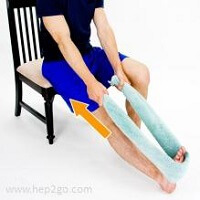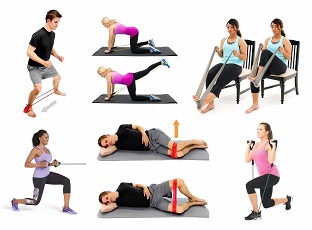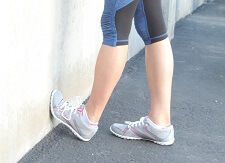- Home
- Knee Symptoms
- Leg Cramps
Calf Cramps
Written By: Chloe Wilson, BSc(Hons) Physiotherapy
Reviewed by: KPE Medical Review Board
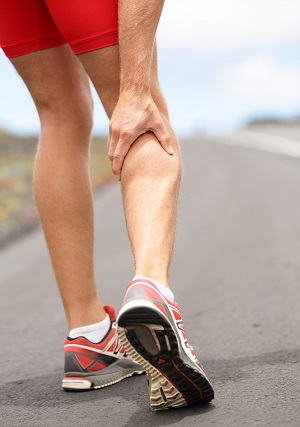
Calf cramps occur when the muscles suddenly and involuntarily contract or tighten and then won’t relax.
Leg cramps can be extremely painful and may last for anything from a few seconds to several minutes, and there may be ongoing discomfort in the affected muscles for a few hours after calf muscle cramps subside.
In some instances there may be visible or palpable hardening in the muscle.
In most cases, leg cramps are completely harmless and settle down quickly, but they can be a sign of an underlying medical problem or electrolyte imbalance.
Cramp, often referred to as Charley Horse, typically affects the calf muscles, gastrocnemius and soleus, but can occur throughout the leg or in the foot.
Muscle cramps typically occurs at night time, after exercise or during pregnancy but can develop for no obvious reason.
What Causes Calf Cramps?
The most common things that cause calf cramps are:
1. Muscle Fatigue
Muscle fatigue a common cause of calf cramps during and after exercise and develops due to a problem with neuromuscular control. This is a complex process, but put simply is the interaction between nerves and muscles which controls movement.

Factors such as low energy, over training, increased intensity or duration of exercise and exercising in hot, humid environments leads to increased activity in the muscle spindles (the sensory receptors in muscles) and decreased activity in Golgi tendons (which control the tension in a muscle).
This all alters the neuromuscular control resulting in Charley Horse. Over-exertion also reduces the muscle’s oxygen supply and increases the amount of waste product in the muscle.
Cramp from muscle fatigue usually occurs:
- In the muscles that are working hardest during activity: for runners that’s the calf and hamstring muscles
- In muscles that cross two joints: such as the gastrocnemius calf muscle that crosses both the knee and ankle joints as they typically work harder than single joint muscles
- With improper pacing: trying to increase your activity level too quickly. Typical in those just starting out or those who suddenly change their training habits
- When you push yourself too hard: you’re more likely to suffer from calf cramps during a race when you put in that extra effort than during training
2. Calf Cramps In Pregnancy

Calf cramps are a common problem during pregnancy, particularly in the second and third trimesters. The exact cause is unknown but is thought to be due to
- Additional Weight: which places extra strain on your muscles
- Changes in Circulation: Your growing uterus puts more pressure on blood vessels affecting the circulation in your legs
- Altered Levels of Nutrients & Salts: the baby takes what it needs from your bloodstream which can leave you slightly short of what you need. Low magnesium levels are thought to be associated with increased risk of calf cramps in pregnancy
3. Medication
Muscle cramps can develop as a side effect from certain medications such as:
- Diuretics: these remove excess fluid from the body through urine and are typically used to treat high blood pressure, congestive heart failure and certain kidney problems
- Statins: used to treat high cholesterol
- Raloxifene: used to prevent osteoporosis (bone thinning)
- Menopause Medication: conjugated estrogens used to reduce hot flushes
Always consult your doctor if you think your problem may be due to your medication – do not stop taking any medication unless advised by your doctor.
4. Neurological Conditions

Problems in the nerves can lead to calf cramps. The most common neural causes of calf cramps are:
- Peripheral Neuropathy:this is where there is damage to the nerves of the leg meaning the signals passing between the brain/spinal cord and the muscles are affected. This can affect the control and co-ordination between the agonist and antagonist muscles resulting in calf cramps
- Spinal Stenosis: Narrowing of the spinal canal places pressure on the nerves in the spine which can cause a cramp like pain in the legs. Pain tends to get worse with walking and may ease by bending forwards slightly as your walk e.g. leaning on a shopping trolley as bending increases the space in the spinal canal thus taking the pressure off the nerve.
Both of these can causes calf cramps and nerve pain in the feet and may be accompanied by tingling, numbness and/or weakness. Find Out More >
5. Health Issues
Muscle cramps may be an indication of an underlying health problem. These may include liver disease (due to a build-up of toxins in the blood which can cause spasms), kidney problems, diabetes, Parkinson’s Disease, restless leg syndrome, hypoparathyroidism, peripheral vascular disease (meaning less blood and oxygen reaches your muscles) and thyroid problems.
6. Sweating & Dehydration
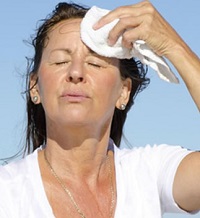
If your body loses too many fluids from sweating or dehydration, there is a drop in fluid and salt levels. This can lead to a loss in blood volume and resultant reduction in the oxygen supply to the muscles, and electrolyte imbalance, both of which can trigger muscle cramps.
This particularly affects athletes training in hot, humid conditions and those who wear full equipment such as American Football players. Excessive alcohol consumption and regular smoking also increase the risk of dehydration.
When playing sport or exercising, it can help to drink specially formulated sports drinks which contain the right combination of electrolytes to help prevent dehydration and cramping.
7. Electrolyte Imbalance
Calf cramps are also commonly associated with electrolyte imbalance, particularly if you have low sodium, potassium, calcium or magnesium levels. Electrolytes help to conduct the body’s electrical impulses that control muscle contraction and relaxation.
Electrolyte imbalance can occur due to excessive sweating, diarrhoea, side effects from medications or underlying health problems. In some cases, it can help to take supplements such as magnesium, particularly for nocturnal cramps – always consult your doctor before taking any medication or supplements.
Dehydration and electrolyte imbalance are often considered to be the most likely cause of calf cramps but more recent studies indicated that this is in fact unlikely.
Why Do Muscles Cramp Up?
Muscles work in pairs – as one muscle contracts (the agonist), the other relaxes (the antagonist) allowing smooth, pain-free movement.
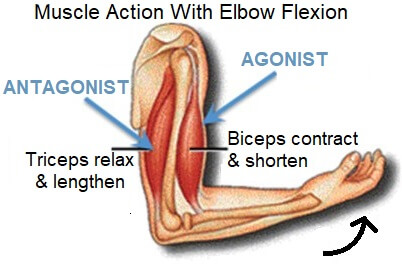
Usually, movement is voluntarily, e.g. if you want to bend your elbow, you brain sends messages to the muscles in your arm telling the biceps (agonist) to contract and shorten and the triceps (antagonist) to relax and lengthen.
With cramp, there is an involuntary contraction of the muscle which you can’t control.
Calf muscle cramp typically strikes during or after exercise, usually due to muscle fatigue, or at night-time (known as nocturnal cramps) due to inactivity or sudden movement.
Calf cramps can develop in two ways, either the agonist contracts too hard and can’t then relax, or the antagonist fails to relax correctly and the muscle spasms.
Treating & Preventing Calf Cramps
Anyone who has suffered from calf cramps will want to know two things – what they can do to stop it when it strikes, and how they can prevent it from happening again. So let’s look at the best options for treating and preventing calf cramps.
1. Rest
If your calf cramps came on during activity, stop what you are doing - for example, if you develop symptoms when you are running, don’t try and push on through it, stop and wait for the symptoms to completely settle. The muscle needs to be given the chance to completely relax and recover.
2. Stretching
Stretching exercises can help to both reduce the risk of developing calf cramps and to treat attacks of cramp.
During An Attack: Stretch the calf muscles, hold the stretch until the muscle completely relaxes and any tension or hardness in the muscle has gone. This may take a few minutes. A good way to do this is to sit up with your leg stretched out and pull your toes up towards you. Alternatively, walk around on your heels (tiptoes lifted) for a few minutes
To Prevent Attacks: Calf stretches done regularly help the muscle to lengthen and can reduce the prevalence of calf cramps. Visit the calf stretches section for a range of exercises that can help
3. Massage
Massage can help during an attack of calf cramps to help relax the muscles. Massage helps to increase the blood flow to muscles which brings with it oxygen and nutrients. During an episode of cramp, massage should be done gently so as not to induce further spasm. Many people find massage guns helpful and reducing the intensity and frequency of cramp attacks.
People who suffer from frequent bouts of cramp may find it helpful to have sports massages to help stretch the muscle and relieve tension and tightness in the calf muscles. Please be aware, sports massages should not be done until at least 48 hours after an injury else there is a risk of further damage.
4. Training Regime
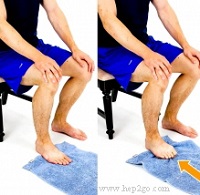
Muscle fatigue is a common cause of cramp, and this often comes about due to inappropriate training. We’ve all done it – decided one day we want to get fitter, or to enter a race and we suddenly up our exercise. We may train harder, longer or more often. But the body takes time to get conditioned.
The best advice is to follow the 10% rule – this means you should increase your activity levels by no more than 10% per week. This applies to distance, duration and speed. This gives your body time to adapt and greatly reduces the risk of injury or of developing calf cramps. Also, make sure you warm up and cool down properly when you exercise.
It also helps to improve the strength and endurance of the calf muscles so they can work more effectively so incorporate some strengthening exercises into your routine too.
5. Rehydrate
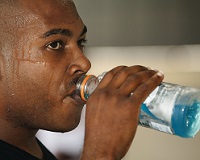
Always keep yourself adequately hydrated, particularly when exercising. Drink plenty of water – the amount you need will depend on things like your age, weight, exercise level and your environment.
You may also want to try sports drinks which also contain electrolytes to help prevent imbalance.
6. Heat
Having a warm shower or placing a heat pad or hot water bottle on your calf can help to improve blood flow and reduce the pain and spasming associated with calf cramps.
There are lots of different heat packs on the market - our favourite is the TrekProof Reheatable Hot/Cold Pack. It is reusable, can be used for heat or ice and comes with a strap to hold it in place. Find Out More >
What Else Can Help?
There are a number of other things that can cause calf pain, so if none of these are sounding like your problem, visit the calf muscle pain diagnosis section for help working out what is wrong and how to treat it.
If your cramp is more in the foot than the calf, visit the foot cramps section on our sister site.
Calf cramps can be extremely unpleasant, but they don’t usually cause any serious problems. Stretching and strengthening exercises really can help to reduce both the intensity and frequency of episodes – visit the calf stretches and calf strengthening exercises sections to find suitable exercises.
Page Last Updated: 31/01/24
Next Review Due: 31/01/26
